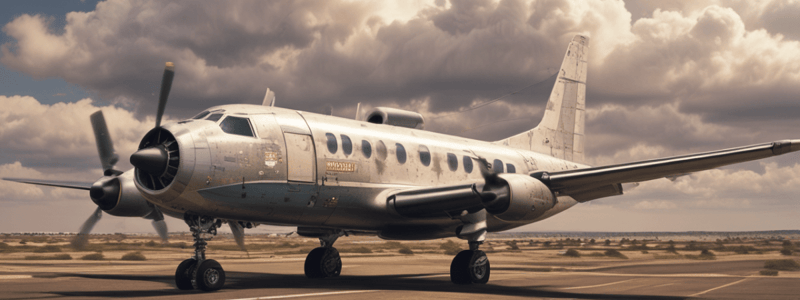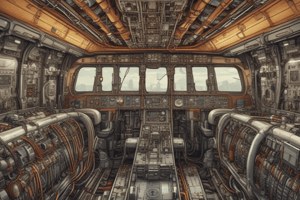Podcast
Questions and Answers
What type of BNC connector is used as an example for assembling coaxial cable?
What type of BNC connector is used as an example for assembling coaxial cable?
- Push-type connector
- Clamp-type connector (correct)
- Twist-type connector
- Screw-type connector
Why is it important to comb out the shield carefully?
Why is it important to comb out the shield carefully?
- To remove the outer jacket
- To avoid nicking the shield (correct)
- To avoid breaking the centre conductor
- To strip the dielectric
What is the purpose of wrapping thin pressure tape around the shielding?
What is the purpose of wrapping thin pressure tape around the shielding?
- To strip the dielectric
- To expose the centre conductor
- To remove the outer jacket
- To form a cone with the narrow end towards the conductor (correct)
What is the recommended trim length for the shield?
What is the recommended trim length for the shield?
What is the purpose of the sleeve clamp in the assembly process?
What is the purpose of the sleeve clamp in the assembly process?
What is added when assembling to RC-62/U or 71/U coaxial cables?
What is added when assembling to RC-62/U or 71/U coaxial cables?
What is the primary purpose of bonding in an aircraft?
What is the primary purpose of bonding in an aircraft?
What is the main difference between bonding and grounding?
What is the main difference between bonding and grounding?
What type of testing is used to check for electrical connections between conducting objects?
What type of testing is used to check for electrical connections between conducting objects?
What is the purpose of functional testing in circuit testing?
What is the purpose of functional testing in circuit testing?
What is the purpose of insulation resistance testing in circuit testing?
What is the purpose of insulation resistance testing in circuit testing?
What should be done after completion of all circuit tests?
What should be done after completion of all circuit tests?
What is the purpose of the petroleum-based abrasive compound in the aluminium terminal lugs?
What is the purpose of the petroleum-based abrasive compound in the aluminium terminal lugs?
What should be used to install MS aluminium terminal lugs?
What should be used to install MS aluminium terminal lugs?
What is the purpose of insulating the aluminium terminal lugs after assembly?
What is the purpose of insulating the aluminium terminal lugs after assembly?
What is the primary difference between uninsulated splices and insulated splices?
What is the primary difference between uninsulated splices and insulated splices?
What should be done if a defective connection is found during a visual inspection?
What should be done if a defective connection is found during a visual inspection?
What is the purpose of the inspection hole in the M81824 environmental splice?
What is the purpose of the inspection hole in the M81824 environmental splice?
What is the recommended stripping length for #22 to #14 wires?
What is the recommended stripping length for #22 to #14 wires?
What type of wire sizes are used for environmental permanent splices conforming to MIL-S-81824?
What type of wire sizes are used for environmental permanent splices conforming to MIL-S-81824?
What should be examined during the inspection of crimped terminations?
What should be examined during the inspection of crimped terminations?
What is used to insulate uninsulated splices after assembly?
What is used to insulate uninsulated splices after assembly?
What is the significance of the color-coding of splices?
What is the significance of the color-coding of splices?
How many times must the crimping operation be performed for M81824 environmental splices?
How many times must the crimping operation be performed for M81824 environmental splices?
What is the main benefit of using stranded copper conductors in aircraft wiring?
What is the main benefit of using stranded copper conductors in aircraft wiring?
What is the primary purpose of coating aircraft wire with tin, silver, or nickel?
What is the primary purpose of coating aircraft wire with tin, silver, or nickel?
What is the main advantage of using aluminium wire in aircraft wiring?
What is the main advantage of using aluminium wire in aircraft wiring?
What is the primary consideration when selecting wire insulation for an aircraft?
What is the primary consideration when selecting wire insulation for an aircraft?
What is the main disadvantage of using cables in aircraft wiring?
What is the main disadvantage of using cables in aircraft wiring?
What is the term used to describe any group of two or more conductors separately insulated and grouped together by an outer sleeve?
What is the term used to describe any group of two or more conductors separately insulated and grouped together by an outer sleeve?
Study Notes
Circuit Testing
- Circuit tests are essential for ensuring system reliability and include bonding testing, continuity testing, insulation resistance testing, and functional testing.
- After completing all tests, the installations should be inspected to ensure that all connections have been re-made and secured, and that test equipment, tools, etc., have been removed.
Bonding and Grounding
- Bonding means electrically connecting two or more conducting objects not otherwise adequately connected.
- Grounding means electrically connecting a conducting object to a primary structure or earth electrode for return of current.
- Bonding and grounding connections are made in aircraft for various purposes, including:
- Protecting aircraft and personnel against hazards from lightning discharge.
- Providing power current return paths.
- Preventing development of RF potentials.
- Protecting personnel from shock hazard.
- Providing stability and consistency of radio transmission and reception.
- Preventing accumulation of static charge.
- Providing fault current return paths.
Bonding of Aircraft Components
- The main types of bonding are used to connect conducting objects and prevent electrical hazards.
Coaxial Cable Assembly Procedures
- Remove 5/16 in. of the outer jacket, exposing the shield, and comb out the shield carefully to avoid breaking shield strands.
- Strip dielectric to 3/16 in. from the edge of the jacket, exposing the centre conductor.
- Disassemble the nut, grooved gasket, and sleeve clamp from the plug or jack body.
- Taper the shield towards the centre conductor and wrap a piece of thin pressure tape around the shielding, forming a cone.
- Slide the nut and gasket (V-groove away from nut) in that order over the tapered shield and onto the jacket.
- Slide the sleeve clamp over the tapered shield until the inside shoulder of the clamp butts flush against the cut end of the jacket.
Inspection of Crimped Terminations
- Examine the crimped connection carefully for:
- Crimp indent centred on the terminal lug barrel
- Indent in line with the barrel
- Terminal lug not cracked
- Terminal lug insulation not cracked
- Insulation grip crimped
EWIS Splicing Procedures
- Environmental permanent splices conforming to MIL-S-81824 are used to join small copper wire sizes No. 26 through No. 10.
- Splices are colour-coded in the same manner as insulated copper terminal lugs.
- The M22520/5 and M22520/10 crimp tools with appropriate dies are the approved tools for crimping these splice sizes.
Aircraft Electrical Wiring
- Several conditions must be considered when choosing an aircraft electrical wire, including design temperature, flexibility requirements, abrasion resistance, strength, insulation, electrical resistance, weight, and applied voltage and current flow.
- The type of conductor and insulation necessary for a given installation is determined by these factors.
- Aircraft wire is made with a stranded copper conductor, either seven or 19 strands for small wire and 19 or more for larger wire.
- The use of stranded wire increases the flexibility of the conductor, thus decreasing the chance of fatigue failure.
Studying That Suits You
Use AI to generate personalized quizzes and flashcards to suit your learning preferences.
Related Documents
Description
Learn about the importance of circuit testing in ensuring system reliability in aircraft electrical circuits, including bonding, continuity, and insulation resistance tests.




